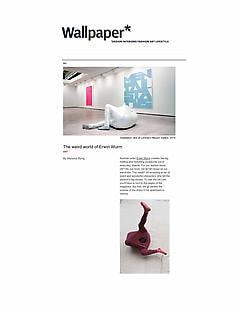
The Weird World of Erwin Wurm
Malaika Byng
Austrian artist Erwin Wurm creates flexing, melting and morphing sculptures out of everyday objects. For our fashion issue (W*144, out now), we let him loose on our wardrobe. The result? An arresting array of weird and wonderful characters who tell the season's big stories. To see the full cast, you'll have to turn to the pages of the magazine. But first, we go behind the scenes of the shoot in his apartment in Vienna.
2010 proved a big year for Wurm, who had a spate of solo shows across Europe, as well his first in New York at Lehmann Maupin Gallery. Next up, he'll be exhibiting at Kunsthallen Brandts in Denmark, followed by everywhere from Gemeente Museum in the Netherlands to Dallas Contemporary in the US. Here, we take a look at some his latest shows, as well as his defining works from the past. Plus, the artist takes time out to talk about fashion, philosophy - and fat cars.
Describe the experience of playing stylist for Wallpaper*?
It was really just an extension of what I'm interested in already. I didn't think how to use a particular suit or jacket. I just used the clothes as the paint.
Are you interested in fashion, or are clothes just a vehicle for you?
Yes, I'm interested in fashion - I wear many of the labels featured. But it's a vehicle at the same time because we explore, express and define ourselves through fashion.
Can you tell us the stories behind some of the characters in the shoot?
Some have a tale to them, while others are more abstract. There's the lonely sailor who finally finds company, then there's the flower seller who turns into a flower himself.
Why do many of your sculptures show people battling with clothing, trapped inside jackets, sweaters and dresses, and struggling to get out?
There's something very beautiful about a struggle to me. But my sculptures are also a game of hide and seek. Sometimes people's faces are visible, and sometimes their identities are obscured by the garments.
As with your pieces for Wallpaper* and your One Minute Sculpture series, your works are often fleeting and their only record is a photograph. Why do you like to create sculptures that don't last?
I like to explore the boundaries between sculpture and performance and examine whether it is possible to draw a line.
Many of your pieces are about people or things in a process of transformation. What prompted this fascination with shape-changing?
I'm interested in the relationship between the form and the content. If you put on a piece of clothing, you can either define or distort your figure. When we change volume we also change content, like with my Fat Car series. The bloated vehicles almost feel human.
What has had the biggest influence on your work?
Definitely philosophy, like the work of René Descartes, and issues of trust and reality. But also the problems of our time, like the way society asks us to be thin, but at the same time, encourages us to consume more and more. And the notion of being forever young.
What is the first image you remember from your childhood?
Building a house in the sand with my grandfather.
What are you working on at the moment?
A major new video project, as well as drawings and furniture pieces. The latter are an extension of the series I began last year.
